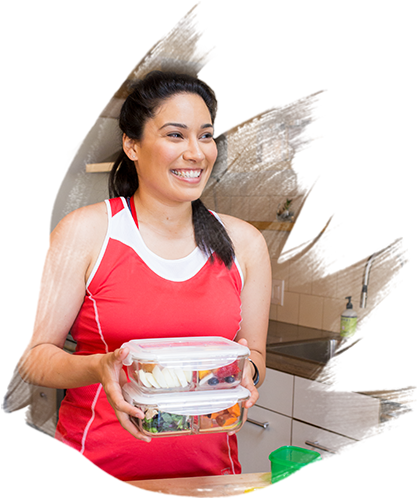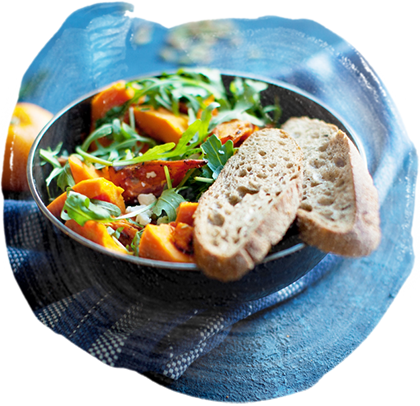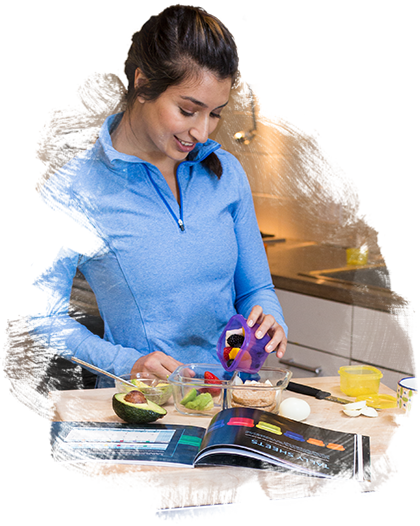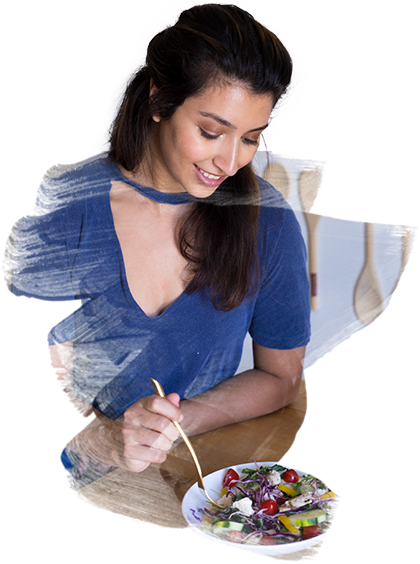Tips To Make Weight Loss
EASIER
The chance of regaining the weight you just lost is pretty high — around 80 percent, some research says. This depressing statistic doesn’t mean that you should give up the good fight. It just means that it’s not easy to maintain weight loss. But you probably already knew that.
Common sense can reveal that if you revert to the old habits that caused you to gain weight, you’ll soon balloon back to where you were. Less commonly known is how weight loss can alter your metabolism and hormones. When you lose body fat, leptin, the hormone that tells your brain you’ve had enough to eat, drops; this increases appetite. In addition, metabolic rate slows when you lose weight because you need fewer calories to maintain your new weight, and your body burns fewer calories when you move. Sucks… but it’s not impossible to stay lean.
This chapter will give you practical advice to ensure the weight doesn’t creep back on.
BODi’S ULTIMATE GUIDE TO WEIGHT LOSS: CHAPTER 3

Tips To Make Weight Loss
EASIER

BODi’S GUIDE TO WEIGHT LOSS: CHAPTER 3
The chance of regaining the weight you just lost is pretty high — around 80 percent, some research says. This depressing statistic doesn’t mean that you should give up the good fight. It just means that it’s not easy to maintain weight loss. But you probably already knew that.
Common sense can reveal that if you revert to the old habits that caused you to gain weight, you’ll soon balloon back to where you were. Less commonly known is how weight loss can alter your metabolism and hormones. When you lose body fat, leptin, the hormone that tells your brain you’ve had enough to eat, drops; this increases appetite. In addition, metabolic rate slows when you lose weight because you need fewer calories to maintain your new weight, and your body burns fewer calories when you move. Sucks… but it’s not impossible to stay lean.
This chapter will give you practical advice to ensure the weight doesn’t creep back on.
Can’t Lose Weight? | How to Start | Make it Easier | What to Eat | Weight Loss Workouts | Maintain My Weight Loss
10 SMALL
THINGS
That Can Help You Lose Weight
When you fall off the weight-loss wagon, it can be tempting to blame yourself — if only you had more willpower, you might be able to stick to your meal plan or resist those midnight cravings. (Sound familiar?)
But your willpower is put to the test way more often than you think. Researchers at the Cornell University Food and Brand Lab found that most people assume they’re faced with food decisions around 15 times a day, but the real number is actually more than 200. And let’s be honest, it’s reeeeeally hard to do the right thing 200 times a day — especially when the right thing is walking past a plate of fresh glazed donuts at work.
You can’t rely on sheer willpower every single time you get a craving. But you can adapt your environment so you’re not forced to make so many choices every day — and that can help you stay on track and lose weight. Here are 10 ways you can create an environment that makes weight loss a little easier.
10
SMALL
THINGS
That Can Help You Lose Weight
When you fall off the weight-loss wagon, it can be tempting to blame yourself — if only you had more willpower, you might be able to stick to your meal plan or resist those midnight cravings. (Sound familiar?)
But your willpower is put to the test way more often than you think. Researchers at the Cornell University Food and Brand Lab found that most people assume they’re faced with food decisions around 15 times a day, but the real number is actually more than 200. And let’s be honest, it’s reeeeeally hard to do the right thing 200 times a day — especially when the right thing is walking past a plate of fresh glazed donuts at work.
You can’t rely on sheer willpower every single time you get a craving. But you can adapt your environment so you’re not forced to make so many choices every day — and that can help you stay on track and lose weight. Here are 10 ways you can create an environment that makes weight loss a little easier.
Tweak your grocery list.
If something’s a constant source of temptation around the house, skip it at the grocery store. If ice cream is your weakness, for example, it’s much easier to resist it once — while you’re standing in the frozen food aisle — rather than every single time you walk past your own freezer.
Instead, stock up on healthy staples you can grab when you’re feeling snackish. “Keep fresh fruits and veggies, single-serve cups of guac and hummus, or turkey slices at eye level in the fridge,” says Laura Burak, M.S., R.D., C.D.N., a nutritionist in New York. When you’re rummaging around for a snack, those will be the first things you see.


Tweak your grocery list.
If something’s a constant source of temptation around the house, skip it at the grocery store. If ice cream is your weakness, for example, it’s much easier to resist it once — while you’re standing in the frozen food aisle — rather than every single time you walk past your own freezer.
Instead, stock up on healthy staples you can grab when you’re feeling snackish. “Keep fresh fruits and veggies, single-serve cups of guac and hummus, or turkey slices at eye level in the fridge,” says Laura Burak, M.S., R.D., C.D.N., a nutritionist in New York. When you’re rummaging around for a snack, those will be the first things you see.

Prep meals in advance.
“People tend to eat much healthier and take in fewer calories when they eat their meals at home,” Burak says. After all, when you’re the chef, you control what ingredients are used and how big your portions are — not to mention you probably won’t start off your home-cooked meal with a pint or two of beer and a jalapeno-popper appetizer.
But when you’re too tired to cook, it can be tempting to just grab takeout on the way home or make a “meal” out of potato chips. (Onion dip counts as a veggie… right? No?)
That’s where meal prep can set you up for success — by cooking a week’s worth of healthy food in advance, you’ll have an easier time sticking to your plan when your busy schedule gets in the way. Keeping healthy, pre-made meals in the fridge makes it a lot easier to resist filling up on junk. Bonus: Research suggests that people who spend more time prepping meals at home tend to eat higher-quality foods.

Prep meals in advance.
“People tend to eat much healthier and take in fewer calories when they eat their meals at home,” Burak says. After all, when you’re the chef, you control what ingredients are used and how big your portions are — not to mention you probably won’t start off your home-cooked meal with a pint or two of beer and a jalapeno-popper appetizer.
But when you’re too tired to cook, it can be tempting to just grab takeout on the way home or make a “meal” out of potato chips. (Onion dip counts as a veggie… right? No?)
That’s where meal prep can set you up for success — by cooking a week’s worth of healthy food in advance, you’ll have an easier time sticking to your plan when your busy schedule gets in the way. Keeping healthy, pre-made meals in the fridge makes it a lot easier to resist filling up on junk. Bonus: Research suggests that people who spend more time prepping meals at home tend to eat higher-quality foods.
Downsize your serving ware.
Using smaller bowls, plates, and serving utensils may actually trick your brain into cutting back on calories.
In one study, participants were given a bowl and a scoop and told to serve themselves ice cream. Those who were given a large bowl served themselves 31 percent more ice cream than people who were given a medium bowl. If they were given a large bowl and a large scoop, they served themselves 53 percent more than someone using the smaller bowl and scoop.
“We are very visual people,” Burak says. “Use smaller plates for your meals, or coffee mugs for your cereal, and you’ll get used to that being a portion that satisfies you.”


Downsize your serving ware.
Using smaller bowls, plates, and serving utensils may actually trick your brain into cutting back on calories.
In one study, participants were given a bowl and a scoop and told to serve themselves ice cream. Those who were given a large bowl served themselves 31 percent more ice cream than people who were given a medium bowl. If they were given a large bowl and a large scoop, they served themselves 53 percent more than someone using the smaller bowl and scoop.
“We are very visual people,” Burak says. “Use smaller plates for your meals, or coffee mugs for your cereal, and you’ll get used to that being a portion that satisfies you.”

Rethink your color palette.
Believe it or not, the color of your plates may affect how much you eat — researchers found that people served themselves 30 percent more food when their plate color matched the food (for example, spaghetti and meatballs on a red plate).
That doesn’t mean you need to stock plates in every color of the rainbow, but you may want to try switching to green plates (to eat more veggies) or blue ones (since blue really doesn’t match anything). Plus, the calming colors may help you slow down, savor your food, and notice you’re getting full before you’re overstuffed.
“Lighter blues and greens may actually help you feel more relaxed and take your time when you’re eating,” says Aviva Gaskill, Ph.D., a clinical psychologist in Pennsylvania.

Rethink your color palette.
Believe it or not, the color of your plates may affect how much you eat — researchers found that people served themselves 30 percent more food when their plate color matched the food (for example, spaghetti and meatballs on a red plate).
That doesn’t mean you need to stock plates in every color of the rainbow, but you may want to try switching to green plates (to eat more veggies) or blue ones (since blue really doesn’t match anything). Plus, the calming colors may help you slow down, savor your food, and notice you’re getting full before you’re overstuffed.
“Lighter blues and greens may actually help you feel more relaxed and take your time when you’re eating,” says Aviva Gaskill, Ph.D., a clinical psychologist in Pennsylvania.
Keep your kitchen clutter-free.
Easier said than done, we know. Your kitchen is a magnet for crumbs, spills, dirty dishes, empty glasses, piles of junk mail, grocery lists, and novelty appliances you’ll probably never use.
But a messy kitchen can make you more likely to reach for unhealthy snacks — especially if you’re already in an out-of-control mindset (and aren’t we all, by the time Friday rolls around?). Take a few minutes to clear your countertops, wipe down the table, and get rid of anything that makes the space feel too cluttered or chaotic.


Keep your kitchen clutter-free.
Easier said than done, we know. Your kitchen is a magnet for crumbs, spills, dirty dishes, empty glasses, piles of junk mail, grocery lists, and novelty appliances you’ll probably never use.
But a messy kitchen can make you more likely to reach for unhealthy snacks — especially if you’re already in an out-of-control mindset (and aren’t we all, by the time Friday rolls around?). Take a few minutes to clear your countertops, wipe down the table, and get rid of anything that makes the space feel too cluttered or chaotic.

Keep fruit on the counter.
Research has shown that people who keep fresh fruit on the counter — and only fresh fruit — typically had lower BMIs than those who didn’t. On one hand, this could be a chicken-or-egg situation — does the fruit bowl actually help people lose weight, or do healthy eaters just like to keep their fruits within reach?
But study author Brian Wansink suspects it’s the “See-Food Diet” in action —you’re more likely to eat what you can see. Either way, it’s a healthy habit to get into, and maybe you’ll grab an apple next time you’re craving something sweet or crunchy.

Keep fruit on the counter.
Research has shown that people who keep fresh fruit on the counter — and only fresh fruit — typically had lower BMIs than those who didn’t. On one hand, this could be a chicken-or-egg situation — does the fruit bowl actually help people lose weight, or do healthy eaters just like to keep their fruits within reach?
But study author Brian Wansink suspects it’s the “See-Food Diet” in action —you’re more likely to eat what you can see. Either way, it’s a healthy habit to get into, and maybe you’ll grab an apple next time you’re craving something sweet or crunchy.
Make mindless snacking difficult.
You know that awkward back corner of the cabinet, or that top shelf you can’t quite reach? Store trigger foods there. While the best bet is to resist buying those foods in the first place, at least it’s harder to nibble mindlessly if you need to climb or crawl to get to them. “Place unhealthy foods out of sight, or hide them in opaque containers,” Gaskill says.


Make mindless snacking difficult.
You know that awkward back corner of the cabinet, or that top shelf you can’t quite reach? Store trigger foods there. While the best bet is to resist buying those foods in the first place, at least it’s harder to nibble mindlessly if you need to climb or crawl to get to them. “Place unhealthy foods out of sight, or hide them in opaque containers,” Gaskill says.

Have designated zones for eating...
…and only for eating. If you have a bowl of cereal in front of the computer, or scarf down an energy bar on your commute to work, you probably aren’t eating mindfully.
“Standing, walking, driving, working, and watching TV while you eat can really distract you from noticing when you are beginning to feel full,” Gaskill says. Nix the distractions so you can pay attention to your hunger and fullness cues.

Have designated zones for eating...
…and only for eating. If you have a bowl of cereal in front of the computer, or scarf down an energy bar on your commute to work, you probably aren’t eating mindfully.
“Standing, walking, driving, working, and watching TV while you eat can really distract you from noticing when you are beginning to feel full,” Gaskill says. Nix the distractions so you can pay attention to your hunger and fullness cues.
Make your bedroom sleep-friendly.
Sleep is so important when you’re trying to lose weight. When you don’t get enough zzz’s, your hunger and fullness hormones get out of whack, and you’re more likely to reach for calorie-laden snacks.
Set up your bedroom for a good night’s sleep: Invest in comfy sheets and a supportive pillow, use calming rose or lavender scents, and resist the urge to check your phone in bed (the blue light emitted by electronics can be disturbing).


Make your bedroom sleep-friendly.
Sleep is so important when you’re trying to lose weight. When you don’t get enough zzz’s, your hunger and fullness hormones get out of whack, and you’re more likely to reach for calorie-laden snacks.
Set up your bedroom for a good night’s sleep: Invest in comfy sheets and a supportive pillow, use calming rose or lavender scents, and resist the urge to check your phone in bed (the blue light emitted by electronics can be disturbing).

Have a backup plan when you're out.
“It’s much easier to control your own home eating environment than [the one] at work or at a party,” Gaskill says. But obviously you can’t just stay home 24/7. (That would probably backfire anyway — boredom can make you more likely to eat unhealthy foods.)
Just plan ahead so you know how you’ll handle temptation. At the office, for example, stash healthy snacks in your desk so you’re not tempted to cruise past the candy bowl every 10 minutes. At a party, Gaskill recommends holding a low-cal drink in one hand and a napkin in the other so you can’t reach for the appetizers as easily. And if your friends usually stay for three rounds at happy hour, plan to get there a little late.
You won’t always be able to control your environment, but if you change what you can, you won’t have to rely on willpower so often — and that means you’ll have plenty to spare when you’re not in your weight-loss comfort zone.
Eventually those healthy choices will become second nature — but in the meantime, check out the next chapter for the best strategies to help you lose weight.

Have a backup plan when you're out.
“It’s much easier to control your own home eating environment than [the one] at work or at a party,” Gaskill says. But obviously you can’t just stay home 24/7. (That would probably backfire anyway — boredom can make you more likely to eat unhealthy foods.)
Just plan ahead so you know how you’ll handle temptation. At the office, for example, stash healthy snacks in your desk so you’re not tempted to cruise past the candy bowl every 10 minutes. At a party, Gaskill recommends holding a low-cal drink in one hand and a napkin in the other so you can’t reach for the appetizers as easily. And if your friends usually stay for three rounds at happy hour, plan to get there a little late.
You won’t always be able to control your environment, but if you change what you can, you won’t have to rely on willpower so often — and that means you’ll have plenty to spare when you’re not in your weight-loss comfort zone.
Eventually those healthy choices will become second nature — but in the meantime, check out the next chapter for the best strategies to help you lose weight.


